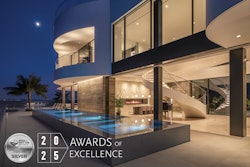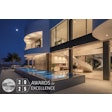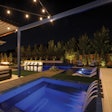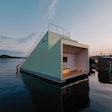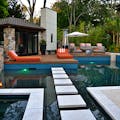Robert Durrua started in the backyard business in late 1984, working as a sales manager for a family owned pool and spa business in New Jersey. "I sold hot tubs and aboveground pools, and in the evening ran the inground pool appointments," he recalls. "I had two part-time schoolteachers working for me on the weekends that sold for me, so I was a 20-something kid that was managing people twice my age. That was a learning experience for me!"
More than 25 years on, Durrua is the vice president of sales in North America for L.A. Spas in Anaheim. We caught him in an airport, waiting to fly home after meeting some dealers in Montreal, to pick his brain about the changes he's seen in the industry.
Why did you hire teachers?
We believed they would be able to educate the consumer on the product. And, as a storyteller myself, I believe it's important not only to educate the consumer about what they're buying and to help them make the right choice, but you also have to tell your story; you have to convey the value message to the consumer so they'll make the right choices. So they did a very good job of fi nding out what the consumer needed and then teaching them about what they were buying.
Back then hot tubs were really in their infancy and people were not really sure what to make of them. They thought Hollywood, Lifestyles of the Rich and Famous. It was fun, but they had no idea what was underneath the skirt, so to speak. So it was important for us to tell people what it was, how it worked, how to take care of it. At least back in the day, these things were a lot of work. They didn't have the automatic systems that they do today so there was a lot of maintenance.
It was a perfect fit, with the teachers. They were off in the summer, and so when we were in season and needed them the most, they needed us, and when our season dropped off, of course they were back in school. The calendar was a perfect fit and what they did professionally was a perfect fit for us, too.
Were shoppers different back then?
People really didn't know what our product was, as I said, but there was a great fascination with them. Dealers would show up at a home show around 1985, '86, and for a lot of people that was the fi rst time they saw our product. It was a novelty. But also around then the home equity loans really started to become popular. They were all the rage, and people couldn't get at that money fast enough, and that led to a boom in the industry — not just hot tubs but decks, screen houses, inground pools. So business really took off. Later in the decade equity lines dried up and of course we entered into the recession we were in about 20 years ago.
But when we were selling hot tubs back then the premium tub was five jets, a single ¾-horsepower pump and maybe a blower. Top of the line was about $5,000.
What was the industry as a whole like back then?
My first trade show was Atlantic City in 1985. Before that I heard stories of how people at the shows would basically strip down and jump into the hot tubs on the show floor! But by the time I arrived the trade shows became a lot tamer.
But the underlying demand for the product then was based on a sexual connotation. But now we tend to promote the health and family togetherness aspects. It's a place for you and your family to gather at the end of the day when the work is done, the kids are in bed, and it's time to reconnect.
And of course there are the health benefits — it helps you get a good night's sleep, eases arthritis pain. As hot tubs became more known to medical professionals they began to realize the benefits of hot water, and they started to get on board with it. The industry really got on board with that and it started to get top billing by the marketing and communication departments.
Does the industry do a good job of explaining the health benefits?
I think early on that message was hit or miss, but I believe the industry has done a very good job of researching the practical health benefits of water in general and hot water specifically. It's well documented that exercise in water is good because of the extremely low impact, then of course the pain relief benefits and such in hot water. All these are well-documented facts and I believe the industry, though trade shows and publications such as AQUA have done a very good job of conveying those benefits. I believe the retailers have picked up on that and delivered the message to the end consumer.
Could anyone have predicted the market would drop as much as it has?
First and foremost, the market is down about 70 percent. We look to our vendors to give us anecdotal information, and that's good, but one of the best sources are the acrylic sheet suppliers, because there's a ratio of 1:1. They can simply count how many sheets they sell and that's the market. I can confirm that the industry is down from, say, 350,000 units annually to about 150,000, just in rough numbers. That's a very significant decline. But did anyone see it coming? I don't think anyone, even with a crystal ball, could have imagined the severity and longevity of our current decline. We've been through cycles before in the early 1980s, then in the early 1990s when home values dropped. During those times some people found themselves slightly upside down, but in today's world the mortgage situation is far, far worse.
I think the smart manufacturers that keep the pulse of the marketplace and the economy, that listen to the warning signs, I think they were prepared to make the necessary adjustments in the business. Those who adjusted their costs to the revenue line are still in business today, and they're profitable, albeit at a lower level.
Have changes in the marketplace changed people's expectations?
When people had lots of disposible cash, they would tend to go out and spend money. In today's climate, most people are fi nding that they're struggling with the equity in their homes. There's no equity line of credit, and credit cards are out of the question because people are trending away from them. Who wants to pay 18 to 20 percent interest for any purchase? So what it really comes down to is what discretionary cash do they have?
When somebody comes into the store today and says they want to spend $5,000, they really mean it. You can get them to stretch that a little, but not as much as you might have in the past. The other difference that we're noticing is that the bandwidth that people want to stay within is the $5,000 to $6,500 price range. We've noticed, though, that the demand for value has remained constant. In other words, they expect the same high quality and high value for products that they were previously spending $8,000 for, but now they're only willing to spend $6,000. So the real challenge for us is to present products that have the features and value and quality that people demand, but at a much lower price point. Innovation in our business has traditionally been, "Who can put on the largest pumps and the most jets and the lighting systems and stereos?" That's all good stuff, but we believe innovation in today's climate is figuring out how to produce a high-quality, high-featured product for less and still provide the opportunity for your retailers to make a good margin. That's where the innovation needs to be and that's what we're working on today.
Comments or thoughts on this article? Please e-mail [email protected].

























